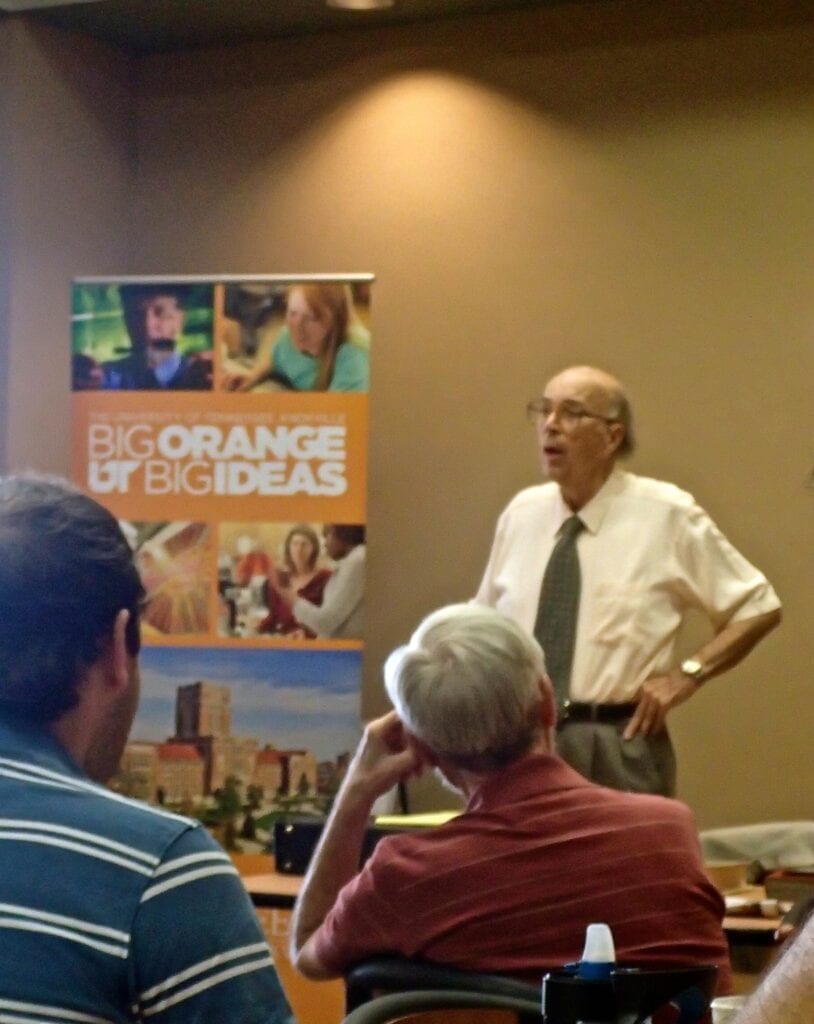Former UT Professor gives talk on Manhattan Project

The audience at the UT Science Forum was treated to a trip back in time on Friday. Former UT Professor, Dr. Ted Lundy, headed up that trip with a lecture about the key events and decisions that led to the creation of the Manhattan Project in the World War II era.
The Manhattan Project was created as a method to defeating the German forces in World War II.
“It was a product of forty years of chemistry and physics research and testing,” Lundy said on Friday.
So where did it all begin? Lundy credits the beginning of the scientific breakthroughs that lead to the Manhattan Project with Marie Curie’s work with Radium. In 1902, Curie successfully isolated the radioactive element.
Shorty after, Einstein proposed his famous Theory of Relativity in 1905. This theory suggests that very small amounts of mass can be converted into great amounts of energy. This scientific breakthrough led to the discovery of nuclear fission.
Otto Hahn, a German physicist, is credited with the discovery of fission after he successfully split an atom in 1938, an accomplishment that would eventually lead to a Nobel Prize in Chemistry. World War II began a year later.
“When an atom splits, a lot of energy is produced,” Lundy said. “Hahn discovered that the nucleus of Uranium could be broken down easily to generate a lot of energy.”
Nuclear fission is a reaction in which an atom’s nucleus is split into two equal parts. From this, up to 100 million volts of energy can be produced from the forces that keep the atom together. Because this process is very difficult to complete with stable atoms, scientists started working with Uranium. Due to its large size, which creates instability, Uranium atoms are split easily. Uranium is also very radioactive and will emit radiation when it naturally decomposes over time.
The exciting discovery of fission prompted many people to fear that this energy could be used as a weapon. Albert Einstein was one of those people. Einstein was concerned that the Germans were developing a very powerful bomb to use against the United States. In 1939, Einstein encouraged President Roosevelt to find a way to harness the energy of fission into a bomb before Germany did.
“President Roosevelt responded by creating the Manhattan Project,” Lundy said.
The main goal of the Manhattan Project was to find a way to separate Uranium and harness the generated energy into a mechanism that would release this energy on impact. This later became the first atomic bomb.
The following years were spent developing methods for attaining and separating Uranium. For this purpose, a 34 million dollar power plant known as Oak Ridge National Laboratory was built in 1943 to pioneer this research.
Scientists knew that for this mechanism, the Uranium isotope U-235 had to be used because it contained the material necessary for the fission reaction to occur. In the process, scientists would overwhelm the nucleus of this atom with neutrons, which would then split U-235. This created an instantaneous chain reaction.
In the chain reaction, a single neutron would split the Uranium nucleus into two separate fragments, which would result in additional neutrons. The produced neutrons would then split other U-235 molecules and generate lots of dangerous heat and energy.
Since so little Uranium exists in the form of U-235, a great deal of time and money was spent investigating a method for producing large amounts of this isotope.
At Oak Ridge, plants were being constructed in record time to facilitate this research. The gaseous diffusion plant was the first to be constructed, and was known as the K-25 plant for secrecy. The Y-12 plant was built to house electromagnetic research and testing. A thermal diffusion plant sprouted up in 69 days and was called the S-50 plant. Lastly, the X-10 plant was built to produce Plutonium, which had successfully undergone fission two years prior.
Great lengths were taken to ensure that the research being done at Oak Ridge remained a secret, even to those who had been recruited to work there. This included building a town around the facility that would house the employees and their families.
“Oak Ridge would not exist today if it were not for the Manhattan Project,” Lundy said.
In 1945, a scientific breakthrough came and two bombs were constructed. One was made of Uranium, called Little Boy and the other of Plutonium, known as Fat Man. Two weeks later, on August 6, 1945, Little Boy was dropped on Hiroshima, Japan. Three days following, Fat Man was dropped on Nagasaki, Japan.
“They wanted to end the war,” Lundy said. “I guess they did.”
The UT Science Forum meets every Friday from 12-1 p.m. in the Thompson Boling Arena Cafe, room C-D.
Edited by Ryan McGill.

